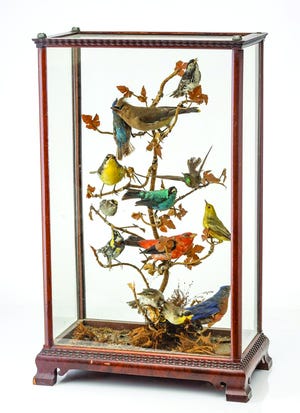
What comes to mind when you think of Victorian antiques? Silver-plated tableware, delicate porcelain dinner services, early photographs and daguerreotypes, and souvenirs commemorating Queen Victoria herself? How about taxidermy? Decorating with preserved animals became fashionable in England by the 1850s and caught on in America in the following decades.

This taxidermy bird diorama was made about 1870. It sold for $3,410, more than twice its high estimate. If you are interested in buying or selling antique taxidermy, check your Department of Wildlife or Fish and Game for regulations. Some species are illegal to buy or sell.
Birds were especially popular in taxidermy. Bird feathers, and sometimes entire birds, appeared on stylish hats from about 1860 to 1920. Taxidermy was seen as an art and a science. Displaying preserved animals in the home was considered a way to show both interest in nature and mastery over it.
However, not everyone approved of the trend. Opposition to hunting and killing birds in mass quantities led to the creation of the Massachusetts Audubon Society 1896. The name came from an earlier society founded by a student of wildlife illustrator John James Audubon’s widow. Similar groups appeared in other states and the National Audubon Society was formed in 1905. It is still operating today.
Question: Years ago, I was given a 3-cent postage machine with a hand crank that was used in drug stores during the war years. It gives three stamps for a dime and was distributed by H.M. Branson Distributing Company, 2nd Street, Louisville, Kentucky. I’d like to know what it’s worth.
Answer: The first class postage rate was 3 cents from July 6, 1932, until Aug. 1, 1958. It was also the rate during World War I, from Nov. 2, 1917, to July 1, 1919. We found advertisements listing the H.M. Branson Distributing Company as a distributor of Rock-Ola phonographs and Bally pinball machines in the late 1940s to the late 1960s. Any coin-operated machine sells. Vintage postage machines sell for about $100. If rare, they sell for more.
Q: I have six never-used Smith & Wesson belt buckles. They’re made from various metals, including brass and silver. I’d like to sell them. Are they worth anything?
A: Horace Smith and Daniel Wesson formed a partnership in Norwich, Connecticut, in 1852. Facing financial difficulties, they sold the company and opened Smith & Wesson in Springfield, Massachusetts, in 1856. The company became one of the leading manufacturers of handguns in the world. Over 100 different Smith & Wesson buckles have been made in various metals since the 1970s. Prices vary widely depending on material, rarity and authenticity. Originally the buckles came in a cardboard box with papers showing authenticity. Later the boxes were made with clear plastic lids. A common buckle in its original box, with papers, sells for about $35. Gold- or silver-plated buckles and special commemorative buckles sell for more, some for over $100. Many buckles listed online are fakes made in China and sell for $10 or less. You can find more information on the Smith & Wesson Collectors Club website, theswca.org.
Q: I’d like some information about the company that made an old desk we have. It’s 27 inches high and has a flat top, one drawer, and a shelf below. It has a paper label that says “William Leavens & Co., Manufacturers, Boston, Mass.”
A: Members of the Leavens family were in the furniture business in Boston beginning in 1874, when George M. Leavens and Thomas Trefry went into business as Leavens & Trefry. The company became G.M. Leavens & Son in 1885. In 1898 it became William Leavens & Company. The company made Mission style furniture, which they called “cottage furniture,” reproduction Colonial furniture and other styles. The customer chose the finish. The company was sold to another Boston furniture company in 1948. A small desk might be worth about $100, depending on condition.
Q: I inherited a silver-plated tea set that includes a teapot, coffeepot, sugar, creamer and tray. The bottom is engraved “WMF Canada.” What is it worth?
A: The initials “WMF” stand for “Wurtemberg Metalware Factory.” The company started as Straub & Schriezer Metalware Factory in Geislingen, Germany in 1853. Later it became Straub & Son. It became Wurtemberg Metalware Factory in 1880. The company made pewter- and silver-plated tableware and cutlery. Its Art Nouveau style silver-plated items made from 1900 to 1910 are popular with collectors today. WMF is still in business, making pots and pans, knives, cutlery, kitchen gadgets, tableware, small appliances and other household products. The value of your tea set depends on style, the number of pieces and condition. WMF silver-plated tea sets like yours have sold recently for $260 to $330. An art nouveau tea set from 1906 in unusual shapes sold for $2,000 last year.
TIP: Clean the feathers on a stuffed bird with chunks of fresh white bread. After cleaning, spray lightly with hair spray.
Terry Kovel and Kim Kovel answer readers’ questions sent to the column. Send a letter with one question describing the size, material (glass, pottery) and what you know about the item. Include only two pictures, the object and a closeup of any marks or damage. Be sure your name and return address are included. By sending a question, you give full permission for use in any Kovel product. Names, addresses or email addresses will not be published. We do not guarantee the return of photographs, but if a stamped envelope is included, we will try. Questions that are answered will appear in Kovels Publications. Write to Kovels, Farm Forum, King Features Syndicate, 628 Virginia Dr., Orlando, FL 32803 or email us at collectorsgallery@kovels.com.
This Link is Source Fromnews.google.com



